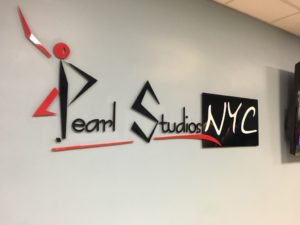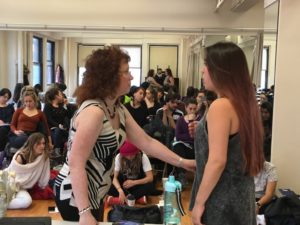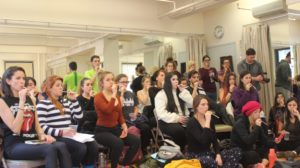International Singers & Actors Meet Long Island Voice Therapist in New York City
They Make Beautiful Music Together!
On Saturday, January 27, 2018, I had a unique opportunity to meet some international talent up close and personal – in a workshop I conducted in New York City, entitled The Singing Voice – Factoids, Myths, and Truths…or…Almost Everything You Wanted to Know About Voice Production, But Were Afraid to Ask. Occasions like this don’t just happen in a New York minute. This three-hour audience-participation voice seminar was a long time in the making. Let me take you back to June 2017…
Thanks to our FANTASTIC website and social media company, DiggsDesign (https://diggs-design.com) we were enjoying a large influx of inquiries through our website form. But one form submission really piqued my interest. It wasn’t from a singer inquiring about lessons, or a potential patient with a voice problem. This inquiry was from a vocal coach and director from Buenos Aires, Argentina, named Marcelo Rosa. Mr. Rosa was working with colleagues from Mexico to arrange for a group of pop and musical theater singers and actors from Argentina, Chile, and Mexico to travel to The Big Apple for a performer’s dream: 2 weeks seeing Broadway shows and working with American professionals who train voice, acting, and movement skills. The goal was for the students to absorb new knowledge and bring that back to their countries. Their trip would culminate in their own performance showcase. The event is called Tu Experiencia Broadway.
So, thanks to technology (and some pretty good English language skills on the part of Mr. Rosa!), we were able to communicate back and forth, figuring out exactly what I could offer this group of 40 young, talented performers, who were so eager to learn as much as they could about being the best performers they could be. We decided on a presentation about care of the performer’s voice, relaxation and posture/alignment work, and my own brand of singing voice therapy exercises. We also wanted to include a mini-master class at the end of the presentation, where I would help any brave volunteers who were having problems with their voices.
 Fast forward to January 27, 2018: We all assembled at Pearl Studios in NYC, way up on the 12th floor. The room was absolutely packed, and everyone was pumped. Hands shot up whenever I needed a volunteer. Our young singers happily participated in circumlaryngeal massage and manipulation (affectionately known as the voice box massage and voice box wiggle in my office). I did this technique for one participant, who realized with amazement that our techniques revealed tension he was having in the perilaryngeal region (i.e., surrounding the larynx or “voice box”). By the way, a big cause of that tension is….{{shock and surprise}}….STRESS! (Good thing young performers trying to make it in show business don’t have any stress!! ?).
Fast forward to January 27, 2018: We all assembled at Pearl Studios in NYC, way up on the 12th floor. The room was absolutely packed, and everyone was pumped. Hands shot up whenever I needed a volunteer. Our young singers happily participated in circumlaryngeal massage and manipulation (affectionately known as the voice box massage and voice box wiggle in my office). I did this technique for one participant, who realized with amazement that our techniques revealed tension he was having in the perilaryngeal region (i.e., surrounding the larynx or “voice box”). By the way, a big cause of that tension is….{{shock and surprise}}….STRESS! (Good thing young performers trying to make it in show business don’t have any stress!! ?).

Use abdominal breath support to protect your delicate throat muscles.
Others discovered that they have been breathing incorrectly for singing and speaking, after a demonstration of the bendover breathing series using a belt around a volunteer’s abdomen for self-feedback. Another great resource that I used to illustrate how our breathing mechanism works is Jessica Wolf’s life-like 3D video, Art of Breathing (you can order this amazing DVD on Amazon using this link: http://amzn.to/2DW584f, or email Jessica Wolf at [email protected] to request a download). It’s a fascinating look at how your breathing mechanism functions, starting with the ribcage. It adds layer upon layer of breathing anatomy, including the diaphragm muscle, lungs and other internal organs (showing their relationship to the often-misunderstood diaphragm), and other muscles associated with respiration.

Vocalize into a straw for a clearer, more relaxed, and more efficiently-produced voice.
As a group, we went through a number of our semi-occluded vocal tract exercises (or SOVT exercises, as they are known). See https://www.voicescienceworks.org/sovt-exercises.html for a user-friendly explanation of how these scientifically-researched techniques can improve the efficiency of your vocal tract by increasing pressure within the tract thus reducing vocal effort, increase beautiful forward tone focus, and reduce injury (or promoting healing of already-injured vocal folds) by allowing the vocal folds to meet in a healthier, squared-up manner. Many singers use some of these warm-ups already, but they aren’t aware of the aerodynamic principles that make them such good exercises. SOVT exercises include vocalizing through a narrow straw, even while blowing bubbles into water. And many of us love the SOVT exercise known as lip trills or lip flutters. Humming, tongue trills, and singing through narrowly pursed lips are additional examples of these great voice-builders and voice-problem-fixers. It’s certainly OK to use more traditional warm-ups such as scales and arpeggios, but to warm up safely, the more closed-mouth SOVT exercises should be first.
Finally, two brave souls came up to participate in a mini-master class. They were each singing in the group’s showcase the next night. One of the young ladies had vocal fold nodules, the other, a polyp on a vocal fold. I used a combination of tongue and jaw relaxation work, posture/alignment, increased abdominal breath support, and humming with tongue-forward position to increase forward tone focus while reducing tongue and laryngeal tension. I even used my “3-Step Method” to reduce the vocal tension often associated with obstructive consonants like /p/, /t/, and /k/ interrupting the flow of sound. (Look for future blogs and posts on posture/alignment, the 3-Step Method, circumlaryngeal massage, and tongue and jaw relaxation). I’m happy to say that both singers made some nice improvement in their tone production, with less strain, reduced voice breaks, and less “airy” mid- to upper-range notes.
One of our most notable moments came when the group participated in an experiment to make judgements based on the sound of pre-recorded readers’ voices. (This “experiment” was loosely based on observations from the infamous Mehrabian study done at UCLA in the 70s. He looked at to what extent a speaker’s tone of voice, body language, and content of the message influence how a listener feels about the speaker. He found that when content and non-verbal aspects of communication conflict, or are not congruent, the non-verbal elements are more important in communication than the content. Read about Albert Mehrabian here: https://en.wikipedia.org/wiki/Albert_Mehrabian).
Solely on the basis of how these 5 readers sounded as they read a standardized passage (there was no video, only audio), the participants were asked to judge the quality of the voice (hoarse, breathy, monotone, nasal, clear). Then they were asked to predict what the readers’ personalities were like, based solely on the quality of their voices (e.g., boring, interesting, insecure, annoying, etc.). The adjectives describing voices and people were flying thick and fast. Surely, some of these readers were judged harshly, merely by listening to them read a 25-second passage. Tough crowd!
The biggest gasp of the day occurred when I let the crowd know that it was amazing how they had made some highly critical statements about 5 very nice, interesting, and intelligent people, based solely on voice quality, because the 5 readers were all…ME!! (A shout-out to my various acting and voice-over mentors at this point).
Judging by some of the comments made at the end of the day (see below), it appears that a very productive day was had by all! Hopefully, we will be able to create vocal excellence again when Tu Experiencia Broadway returns next summer!
Comments by the participants:
It was fun and entertaining.
I really liked the part where we talked about anatomy, the voice box, the cords…
The examples were really clear, and the information was well organized. The exercises will help me as a performer, giving my voice longevity and health.
How it will help you as a performer: “…awareness of the dangers of unhealthy use of the voice, and how to avoid them and take care of the voice.”
I loved that she was absolutely prepared. She gave real-life examples, and the fact that she sang and had experience made her incredibly relatable.

Good posture and alignment are essential for healthy voice production.





